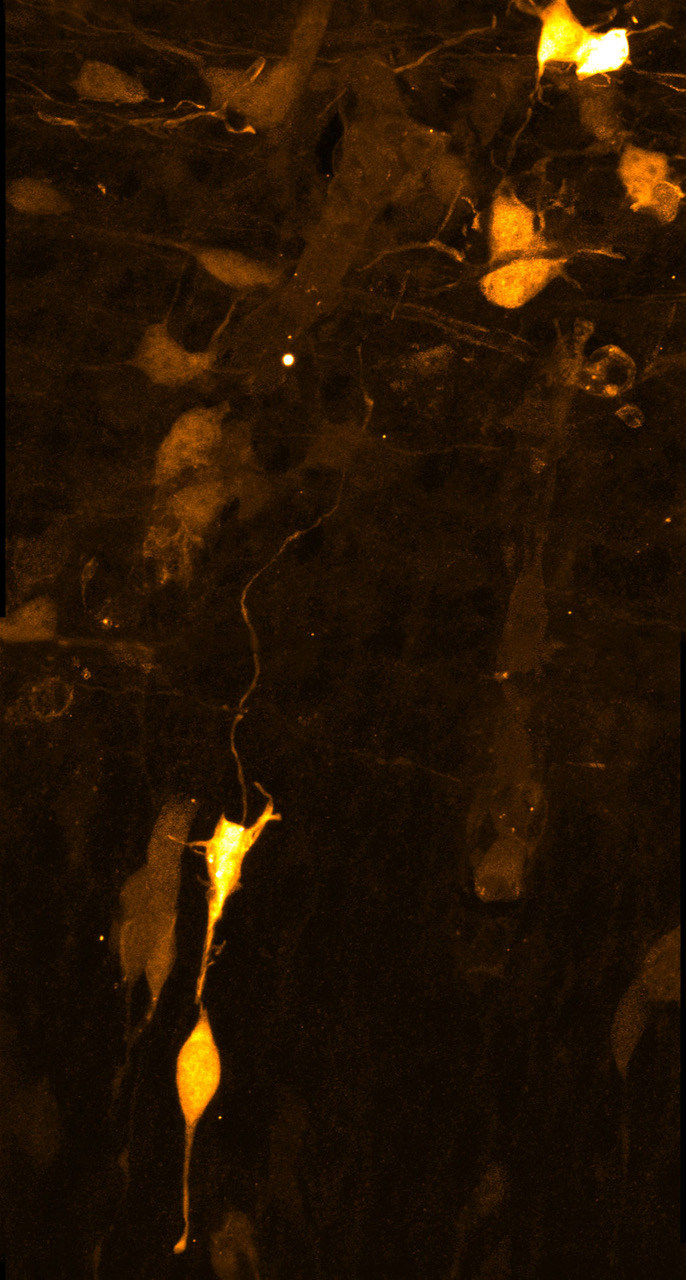
Apical progenitor cell to basal radial glial cell transition after CRISPR/Cas9-mediated depletion of Plekha7 in the mouse developing neocortex. © Tavano/Huttner / MPI-CBG
During evolution, the size of the human brain and the number of neurons therein increased, especially in a particular region called the neocortex. This part of the brain is responsible for higher cognitive functions like speaking and thinking. Key questions regarding the evolutionary expansion of the human neocortex are: (i) which factors limit the number of neurons that are generated during neocortical development, and (ii) how can these limitations be overcome? One important limiting factor is the number of neural progenitor cells in the developing neocortex (these are cells that produce neurons). These progenitor cells stay close to the ventricular surface in species with a less-expanded neocortex, whereas in the developing human neocortex, the neural progenitor cells are greatly increased in a specific germinal zone beneath the ventricular surface, called the subventricular zone. Despite recent scientific progress, the understanding of fundamental molecular mechanisms controlling the formation of the subventricular zone is still largely incomplete. Researchers at the Max Planck Institute of Molecular Cell Biology and Genetics (MPI-CBG) in Dresden, with the help of collaborators at the DFG-Center for Regenerative Therapies Dresden, Cluster of Excellence at the TU Dresden, have now identified a novel molecular mechanism underlying the delamination of neural progenitor cells, a critical step in the formation of the subventricular zone.
The delamination of neural progenitor cells is a process by which progenitor cells lose contact with the ventricular surface in the developing brain, which allows them to migrate to the subventricular zone. The ventricular surface is quite a crowded place – progenitor cells do not have sufficient space there to produce the large number of neurons found in mammalian, and notably primate, brains. In order to escape this crowded area to overcome this limitation, apical progenitors generate basal progenitor cells, which migrate to the more spacious subventricular zone. But how do the cells manage to do this? Stefania Tavano, the lead author of the study, explains: “Newborn basal progenitor cells express a protein called Insm1. Insm1 works like a controller that stops the expression of certain proteins. In newborn basal progenitor cells, Insm1 stops the expression of Plekha7, which is essential for keeping the progenitor cells attached to the ventricular surface. When Plekha7 is missing, cells are free to migrate to the subventricular zone.” But how is this important for the expansion of the human neocortex? When Insm1 is added to, or Plekha7 removed from, apical progenitors, they lose their contact to the ventricular surface. Moreover, they then turn into a specific type of basal progenitor called basal radial glial cell. Basal radial glial cells are highly abundant in the human subventricular zone and are important for its expansion. Intriguingly, it has been shown that apical progenitors in the human brain can directly turn into basal radial glial cells by losing contact with the ventricular surface. This is extremely similar to what the scientists describe. Wieland Huttner, who supervised the study, summarizes: “We not only identified a novel molecular mechanism underlying neural progenitor cell delamination, a process that is of key importance for the expansion of the neocortex, but also delineate a possible process how apical progenitors can directly become basal radial glial cells.” Delamination constitutes a crucial prerequisite for the formation of the subventricular zone, and hence for its expansion during human brain evolution.
Tavano, Stefania et al.: Insm1 Induces Neural Progenitor Delamination in Developing Neocortex via Downregulation of the Adherens Junction Belt-Specific Protein Plekha7, Neuron, March 1, 2018